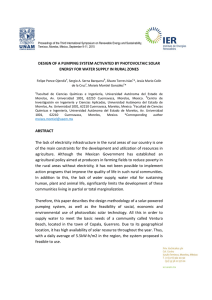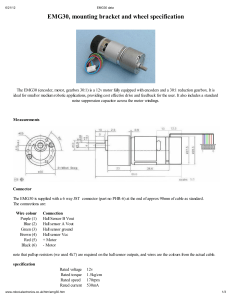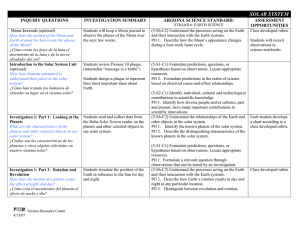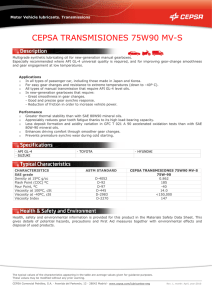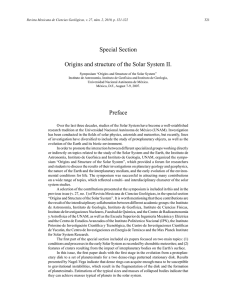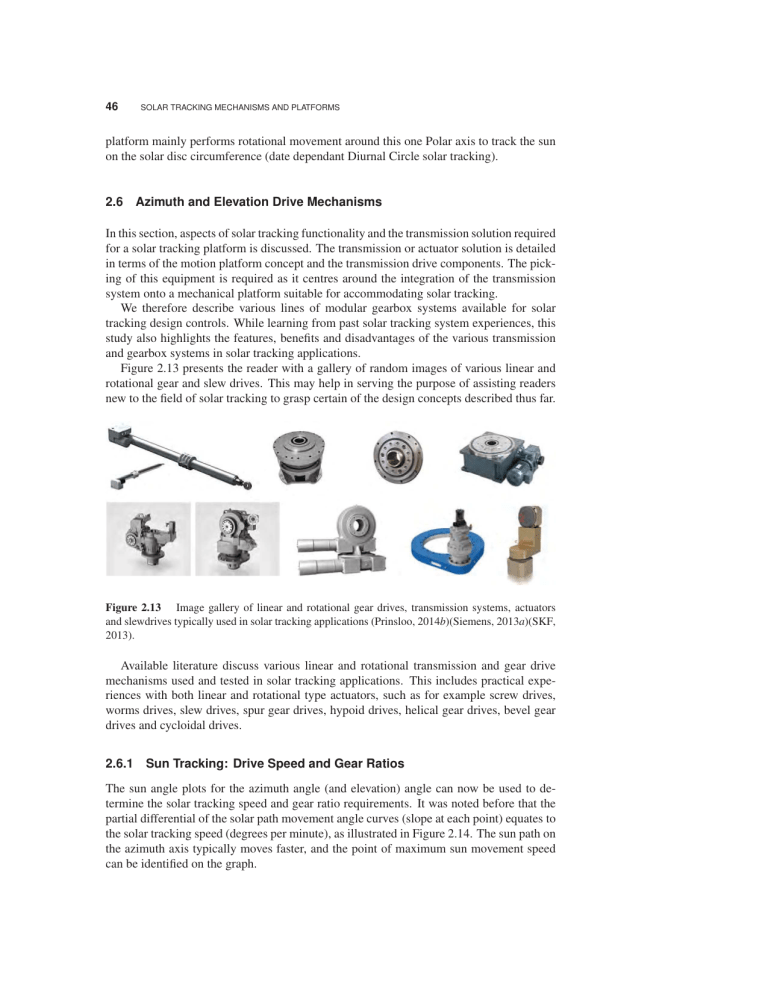
46 SOLAR TRACKING MECHANISMS AND PLATFORMS platform mainly performs rotational movement around this one Polar axis to track the sun on the solar disc circumference (date dependant Diurnal Circle solar tracking). 2.6 Azimuth and Elevation Drive Mechanisms In this section, aspects of solar tracking functionality and the transmission solution required for a solar tracking platform is discussed. The transmission or actuator solution is detailed in terms of the motion platform concept and the transmission drive components. The picking of this equipment is required as it centres around the integration of the transmission system onto a mechanical platform suitable for accommodating solar tracking. We therefore describe various lines of modular gearbox systems available for solar tracking design controls. While learning from past solar tracking system experiences, this study also highlights the features, benefits and disadvantages of the various transmission and gearbox systems in solar tracking applications. Figure 2.13 presents the reader with a gallery of random images of various linear and rotational gear and slew drives. This may help in serving the purpose of assisting readers new to the field of solar tracking to grasp certain of the design concepts described thus far. Figure 2.13 Image gallery of linear and rotational gear drives, transmission systems, actuators and slewdrives typically used in solar tracking applications (Prinsloo, 2014b)(Siemens, 2013a)(SKF, 2013). Available literature discuss various linear and rotational transmission and gear drive mechanisms used and tested in solar tracking applications. This includes practical experiences with both linear and rotational type actuators, such as for example screw drives, worms drives, slew drives, spur gear drives, hypoid drives, helical gear drives, bevel gear drives and cycloidal drives. 2.6.1 Sun Tracking: Drive Speed and Gear Ratios The sun angle plots for the azimuth angle (and elevation) angle can now be used to determine the solar tracking speed and gear ratio requirements. It was noted before that the partial differential of the solar path movement angle curves (slope at each point) equates to the solar tracking speed (degrees per minute), as illustrated in Figure 2.14. The sun path on the azimuth axis typically moves faster, and the point of maximum sun movement speed can be identified on the graph. AZIMUTH AND ELEVATION DRIVE MECHANISMS 47 Figure 2.14 Solar azimuth and elevation angles of the daytime sun path for a certain geographical location (Ray, 2012), with the slope of the azimuth curve representing of the maximum sun movement speed superimposed. With reference to Figure 2.14, one can determine the speed of the sun in degrees per minute by using the parameters obtained from the figure (at the point of maximum slope) in the formula given in Equation 2.1 below. SunSpeed(degree/min) = ∆SunAngle (degrees) δtime (minutes) (2.1) Equation 2.1 computes the speed of the sun in degrees per minute. However, to relate the speed of the sun to motor speed, we need to convert the sun speed to revolutions per minuted (rpm or RPM). Still referring to Figure 2.14, one can therefore determine the speed of the sun in rpm by dividing by 360◦ as in Equation 2.2 below. SunSpeed(degree/min) (2.2) 360◦ Depending on the location of the observer, Equation 2.2 will show that the sun is moving on average at an angular speed of around 0.25◦ per minute (Stine and Geyer, 2001). Thus, on the fastest moving solar tracking axis, namely the azimuth axis (see Figure 2.14), er axis should achieve an angular rate of movement of at least 0.25◦ /mi /min the solar tracker to keep up with the relative sun movement. To achieve an angular movement rate of 0.25◦ /min,, Equation 2.2 shows that a minimum rotational motion speed of 0.000694 rpm (0.25 25◦ /360 360◦ = 0.000694 rpm) is required to accomplish successful solar tracking. Electrical motors typically move at a rate of around 1750-2000 rpm. This means that an electrical motor on its own would thus not achieve such slow rate of movement with adequate torque to drive solar tracking. Therefore a gear drive or transmission system is required to gear-down motor speed while providing sufficient torque at slower solar tracking speeds. With a gearbox on the fastest moving axis, namely the azimuth axis on Figure 2.14, the motor shaft still needs to turn at a certain minimum required speed in order for the tracker to keep up with the movement of the sun. To determine this minimum required rotational SunSpeed(rpm) = 48 SOLAR TRACKING MECHANISMS AND PLATFORMS speed for a tracking motor, one can use Equation 2.3 with the sun speed (rpm, determined in Equation 2.2) as follows: M otorShaf tM in (rpm) = SunSpeed(rpm) × Gearratio (2.3) where the Gearratio is determined as follows: Gearratio = (M otorinput speed ) (Gearboxoutput speed ) (2.4) If the motor and gearbox combination cannot reach the minimum required speed calculated in Equation 2.3, then a different gear ratio (gearbox or transmission system) or higher speed motor needs to be selected. From Equation 2.3, the maximum allowable gear ratio or reduction gearing allowed to convert vert a typical rotational speed of a motor of 1750 rpm to the minimum required tracking speed of 0.000694 rpm (solar tracking speed), then the gear ratio of the transmission or gear drive system is computed to be around 2,000,000:1 (1750/0.000694). With such an abnormally high gear ratio, a solar tracker gear drive system and a 1750 rpm motor will just be able to keep up with the sun movement during maximum sun movement. Typically, a more practical and realistic gear drive system for solar tracking uses a transmission system with a gear ratio between 10,000:1 and 30,000:1. With such gear ratios, solar tracker rotational movement is normally faster than the rotational movement speed of the sun (0.000694 rpm). This is the reason why on/off type solar tracking control systems are used, to synchronise the solar tracker angular rotational movement on the ground with the sun’ss movement in the sky (solar tracking control described later in Section 8.3.2) Knowing that one can determine the maximum angular speed of the sun in rpm (Equation 2.2), one can alternatively determine the minimum required rotational motor speed for a given gear ratio that is more realistic or practical. This makes it possible to select a typical solar tracking gearbox or transmission system and then select a motor with sufficient speed to meet the requirement in Equation 2.3. In this regard, Equation 2.5 can be used to relate the speed of the motor and gear drive axles to the eventual rotational speed of the solar tracking system axis. This formula is valuable to determine the rotational speed of the tracker on either axis from the motor shaft rpm and the gear ratio of the gearbox or transmission system on that axis, and is very handy when the motor speed is fixed or if the motor gear drive can only operate within a certain rpm range. SunT rackerSpeed(rpm) = M otorShaf t(rpm) Gearratio (2.5) Using Equation 2.5 in a typical practical example, we will show how to compute the rotational speed of the solar tracking axis shaft (rpm) from the motor shaft speed (rpm) and the gear ratio. Assume we have a transmission system with a gear ratio of 15,000:1 and a motor speed around 1750 rpm, then the rotational solar tracking movement calculated from Equation 2.5 will be around 0.175 rpm. This means the rotational solar tracking speed would be roughly 250 times faster than the point of fastest movement of the sun on the azimuth axis (Equation 2.2). Continuing with this example, we can compute the solar tracking speed by selecting a slower speed motor or by slowing down the speed of the motor with PWM or VFD drives (as discussed later in Sections 9.2.1 and 9.2.2) to operate at a different efficiency point AZIMUTH AND ELEVATION DRIVE MECHANISMS 49 (see Figure 2.15). Say we reduce the motor speed down to around 20 rpm and still use the same gearbox with gear ratio of 15,000:1, then the rotational solar tracking movement speed calculated from Equation 2.5 will be around 0.00133 rpm. This means a rotational solar tracking speed roughly double the maximum speed of the movement of the sun on the azimuth axis (Equation 2.2). This motor gearbox/transmission system combination will therefore be able to keep up with the maximum solar movement as the motor shaft rotational speed will me above the minimum of Equation 2.3. Figure 2.15 Example of motor performance curves and optimal operation points for a typical DC motor (left) and a typical DC motor running at a reduced voltage (right) (Johnson Electric, 2014). In order to reach an optimum solar tracking motor/gearbox solution, the designer should strive to select a motor/gearbox combination that is able to deliver an acceptable solar tracking and motor speed (Motor Shaft rpm in Equation 2.5), such that the electrical motor operates as close as possible to its point of maximum torque or maximum efficiency as per the motor performance curve (see Figure 2.15). The motor performance curve or test graph is thus a crucial resource during this part of the design phase. The designer should further ensure that the tracking speed or rotational solar tracking angular movement of the solar tracker is at least within the same order or a higher speed than the rate of movement of the sun on the azimuth axis at the point of maximum solar movement (as per Equation 2.1 and Figure 2.14), otherwise the tracker may lag the sun at certain stages. The remaining discussion will now focus features of gear drives and transmission systems typically used in solar tracking applications. 2.6.2 Sun Tracking: Linear Drives Linear drives can provide the necessary mechanical movement and torque to enable realtime solar tracking and for the controller to accurately follow the sun as it moves in it’s trajectory across the sky. Some linear actuators integrate a motor drive with a screw, gearbox, control board, position sensor, limit switches, in a lubricant dust sealed housing. This makes these drives a popular choice of drive in photovoltaic solar tracking systems. Linear drives are often of the ball screw jack type. These drives inherently offer large transfer rations with limited ge transfer ratios in turn ensure movement control at lower levels of current backlash. Large consumption. An important practical consideration in using linear drives in solar automation or tracking applications is the relevant industry specification (Bisenius, 2012). The Since the linear

